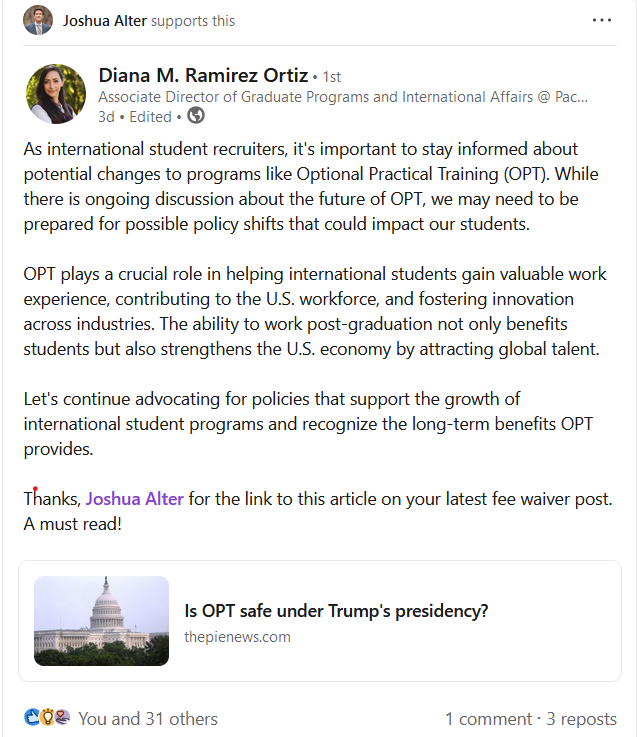Before wrapping up my time at Northwestern University Pritzker School of Law, I spent early January in San Francisco for the 2025 annual meeting of the Association of American Law Schools (AALS).
AALS’s annual meeting is an important conference for U.S. law school faculty and administrators, a time to come together to discuss the latest trends and topics in U.S. legal education alongside the latest scholarship.
This was my first time in attendance, as both an officer for the Section on Post-Graduate Legal Education and as a panelist, and I really enjoyed the learning experience throughout. I also finally got to meet my colleagues at The National Jurist in person.

The panel I spoke on was titled, “Is post-graduate legal education in the U.S. still globally attractive?” We heard excellent insights from my co-panelists, experts on broader international student interest in the U.S., international student interest in U.S. law schools and what one U.S. law school is doing to support its international students.
I focused my portion on insights from the types of international students U.S. law schools are quite interested in recruiting, through interviews with my former LEALS students weighing their global options and insights from Beyond Non-JD readers. The short answer, for me, was yes. But with some important context and considerations for U.S. law schools, especially deans and finance teams seeking the revenue boosts international students often provide.
I have written monthly pieces for International Jurist on some of the very real advantages U.S. law schools enjoy against their global competition. Clear paths to certain key bar exams, the ability to gain work experience during LL.M. studies at some schools, and paths to post-LL.M. work in the United States and earning U.S. salaries. Those advantages are alongside the strong alumni networks that many U.S. law schools possess globally, the attractiveness of the LL.M. credential in many markets, the ability to experience life in the U.S. and exposure to the U.S. legal system and U.S. legal practice to enhance global careers. Overall, I expect the U.S. to continue to be a leading choice for the types of foreign-educated students U.S. and other global law schools seek to attract.
But that doesn’t mean entirely smooth sailing and U.S. law schools should avoid complacency. Collectively, U.S. law schools face some challenges to their leading position in the global race for international students and tuition. But there are ways that they can rise to the occasion in uncertain times.
U.S. law schools and their employees benefit from international students. The financial aspects are well known. Bringing foreign-educated lawyers into U.S. law schools, at different stages of their careers and offering different perspectives and experiences, can positively impact the overall communities. The practice of law is truly global, and U.S. law students who internalize this have opportunities throughout their J.D. experiences to connect with three cohorts of foreign-educated law graduates in LL.M. programs. Some of whom will return home to enhance or begin their careers. Others who will stay in the United States for a career pivot.
Over the next few posts, I’ll go into a little more depth into some of the challenges. They include (1) three acronyms that U.S. law school leaders need to focus on: OPT, ABA and USD; (2) the increasing global competition for tuition-paying law students, including in jurisdictions known for the students who study in places like the United States; and (3) geopolitical and domestic considerations.
Some challenges are easy, or at least easier, for U.S. law schools to address. Others are significantly harder for the people in U.S. law schools, or even their parent universities, to dictate, or even influence significantly.
But there is plenty U.S. law schools can do to continue to welcome international students. One of the easiest is being visible and being visibly supportive. After I posted a PIE News article, “Is OPT safe under Trump’s presidency,” I greatly enjoyed seeing the post below from my colleague Diana Ramirez Ortiz, who you may recall being profiled in my April 2024 International Jurist piece on exchange programs and LL.M. mobility.

To me, Ramirez Ortiz (a former LL.M. and J.S.D. herself), and to many international LL.M. students I speak with, visibility and support are important. LL.M. students I speak with are quite aware that U.S. law schools don’t control OPT, for example. But they look to their schools and their schools’ alumni networks to help navigate the process as it currently exists. They prefer that schools talk about post-LL.M. employment options and realities during recruitment and before deposits, not just once they arrive. And they expect that more of the tuition revenue they spend goes into career advising support, as they look across the metaphorical hall and see so much focus on J.D. student outcomes.
Schools are getting better at this, which is a good thing for everyone involved, and this will allow the U.S. to continue to welcome large numbers of international students into U.S. law schools.
But there is still plenty of room for improvement.

